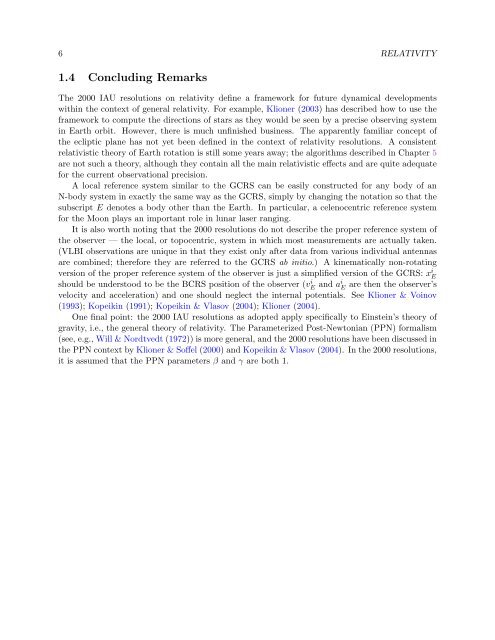USNO Circular 179 - U.S. Naval Observatory
USNO Circular 179 - U.S. Naval Observatory
USNO Circular 179 - U.S. Naval Observatory
You also want an ePaper? Increase the reach of your titles
YUMPU automatically turns print PDFs into web optimized ePapers that Google loves.
6 RELATIVITY<br />
1.4 Concluding Remarks<br />
The 2000 IAU resolutions on relativity define a framework for future dynamical developments<br />
within the context of general relativity. For example, Klioner (2003) has described how to use the<br />
framework to compute the directions of stars as they would be seen by a precise observing system<br />
in Earth orbit. However, there is much unfinished business. The apparently familiar concept of<br />
the ecliptic plane has not yet been defined in the context of relativity resolutions. A consistent<br />
relativistic theory of Earth rotation is still some years away; the algorithms described in Chapter 5<br />
are not such a theory, although they contain all the main relativistic effects and are quite adequate<br />
for the current observational precision.<br />
A local reference system similar to the GCRS can be easily constructed for any body of an<br />
N-body system in exactly the same way as the GCRS, simply by changing the notation so that the<br />
subscript E denotes a body other than the Earth. In particular, a celenocentric reference system<br />
for the Moon plays an important role in lunar laser ranging.<br />
It is also worth noting that the 2000 resolutions do not describe the proper reference system of<br />
the observer — the local, or topocentric, system in which most measurements are actually taken.<br />
(VLBI observations are unique in that they exist only after data from various individual antennas<br />
are combined; therefore they are referred to the GCRS ab initio.) A kinematically non-rotating<br />
version of the proper reference system of the observer is just a simplified version of the GCRS: xi E<br />
should be understood to be the BCRS position of the observer (vi E and aiE are then the observer’s<br />
velocity and acceleration) and one should neglect the internal potentials. See Klioner & Voinov<br />
(1993); Kopeikin (1991); Kopeikin & Vlasov (2004); Klioner (2004).<br />
One final point: the 2000 IAU resolutions as adopted apply specifically to Einstein’s theory of<br />
gravity, i.e., the general theory of relativity. The Parameterized Post-Newtonian (PPN) formalism<br />
(see, e.g., Will & Nordtvedt (1972)) is more general, and the 2000 resolutions have been discussed in<br />
the PPN context by Klioner & Soffel (2000) and Kopeikin & Vlasov (2004). In the 2000 resolutions,<br />
it is assumed that the PPN parameters β and γ are both 1.


